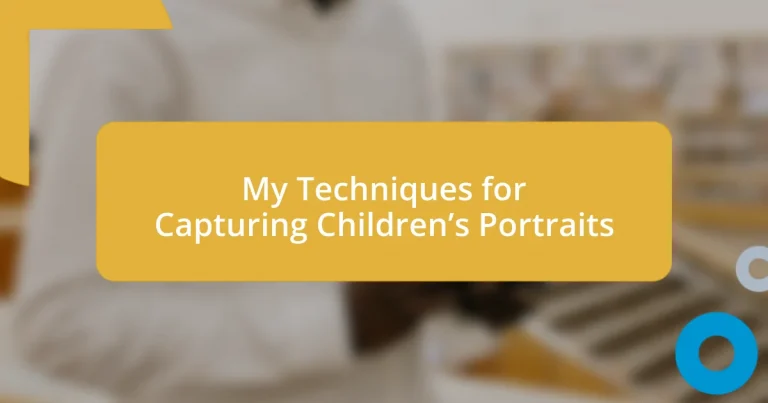Key takeaways:
- Understanding children’s emotional and playful nature is crucial for capturing authentic portraits, often requiring adaptability and gentle engagement.
- Choosing the right equipment, such as a DSLR/mirrorless camera and fast lenses, along with proper lighting and accessories, enhances the quality of children’s portraits.
- Creating a comfortable environment with familiar settings and playful interactions fosters genuine expressions, leading to vibrant and memorable images.
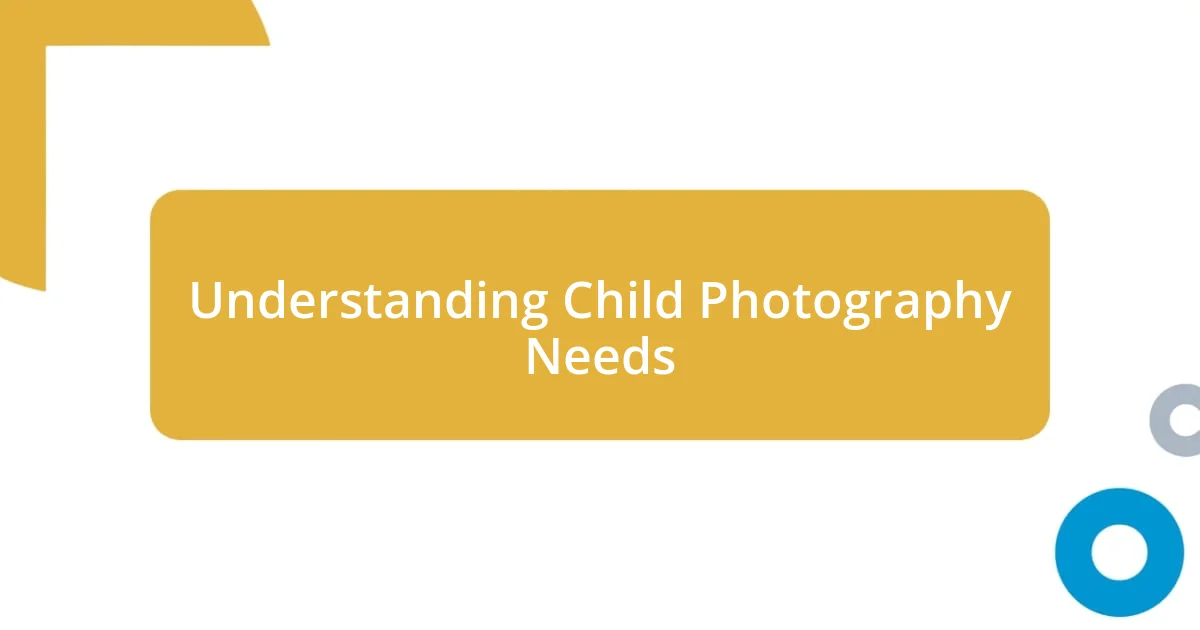
Understanding Child Photography Needs
Understanding the unique needs of children in photography is vital for capturing their true essence. I remember one particular session where the young subject was incredibly shy. By gently interacting and encouraging her to play, I was able to ignite her natural smile. Have you noticed how sometimes all a child needs is a little encouragement to express themselves?
Children are unpredictable and full of energy, and this brings both challenges and joys to the photography process. In my experience, I’ve learned that being adaptable is essential; if a child suddenly starts running in a new direction, I take it as an opportunity to follow. This spontaneous behavior often leads to candid moments that truly reflect their personality. Don’t you find that the best photos often arise when you least expect them?
It’s also important to understand the emotional landscape of a child’s world. When I worked with a group of siblings, I noticed that each child had a different comfort level in front of the camera. By paying attention to their moods, I adjusted my approach, focusing on creating a fun atmosphere. That little shift made a remarkable difference, resulting in vibrant and authentic portraits. Have you ever experimented with adjusting your approach based on a child’s emotional cues?
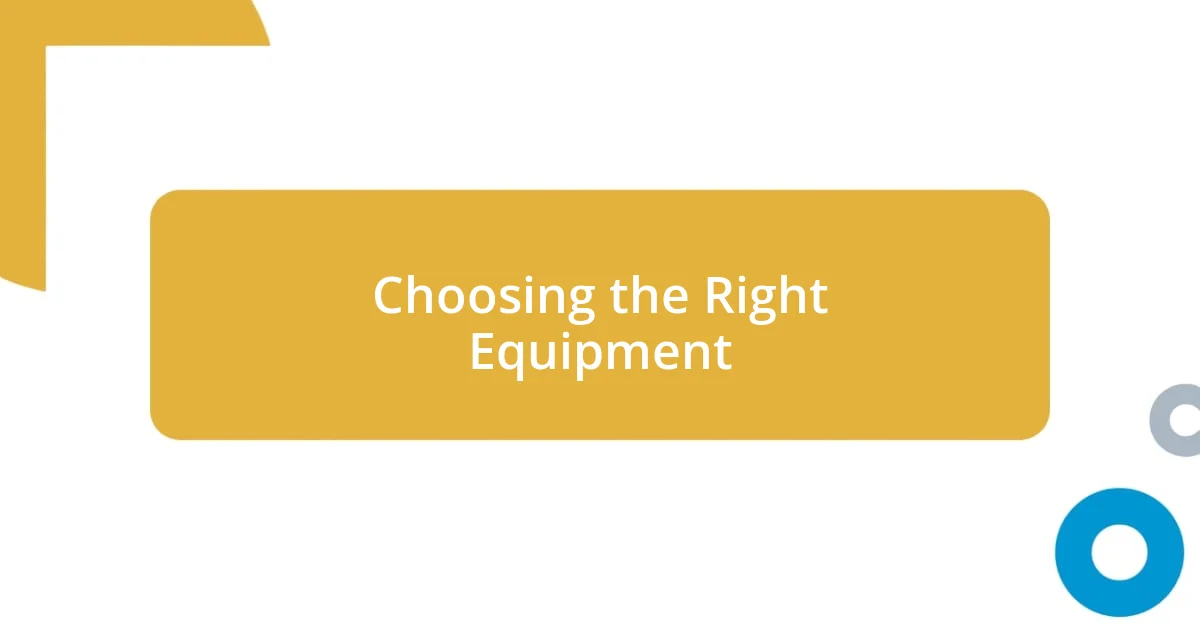
Choosing the Right Equipment
Choosing the right equipment for capturing children’s portraits is crucial to ensure you get the best results. From my experience, a DSLR or mirrorless camera with a fast lens is ideal. I once used a 50mm f/1.8 lens during a park shoot, and it allowed me to capture beautiful, soft backgrounds while keeping the focus on the child’s expression.
Lighting is another vital aspect to consider. Natural light works wonders with children, as it creates a warm, inviting atmosphere. However, having an external flash can be a lifesaver in low-light conditions or when shooting indoors. I remember one rainy day when I had to set up in a living room; my external flash helped me maintain proper exposure and capture the kiddos’ playful interactions without harsh shadows.
Additionally, don’t overlook the importance of accessories. A sturdy tripod stabilizes your shots, and even a reflector can help bounce light onto your little subjects’ faces. I once used a reflector during an outdoor session, and it brightened a shy child’s smile, making the image truly pop. Understanding the right gear enhances your ability to capture those fleeting moments authentically.
| Equipment Type | Advantages |
|---|---|
| DSLR/Mirrorless | High image quality, interchangeable lenses |
| Fast Lens (e.g. 50mm f/1.8) | Shallow depth of field, great for portraits |
| External Flash | Improved lighting in low-light situations |
| Tripod | Stability for sharper images |
| Reflector | Enhances natural light on subjects |
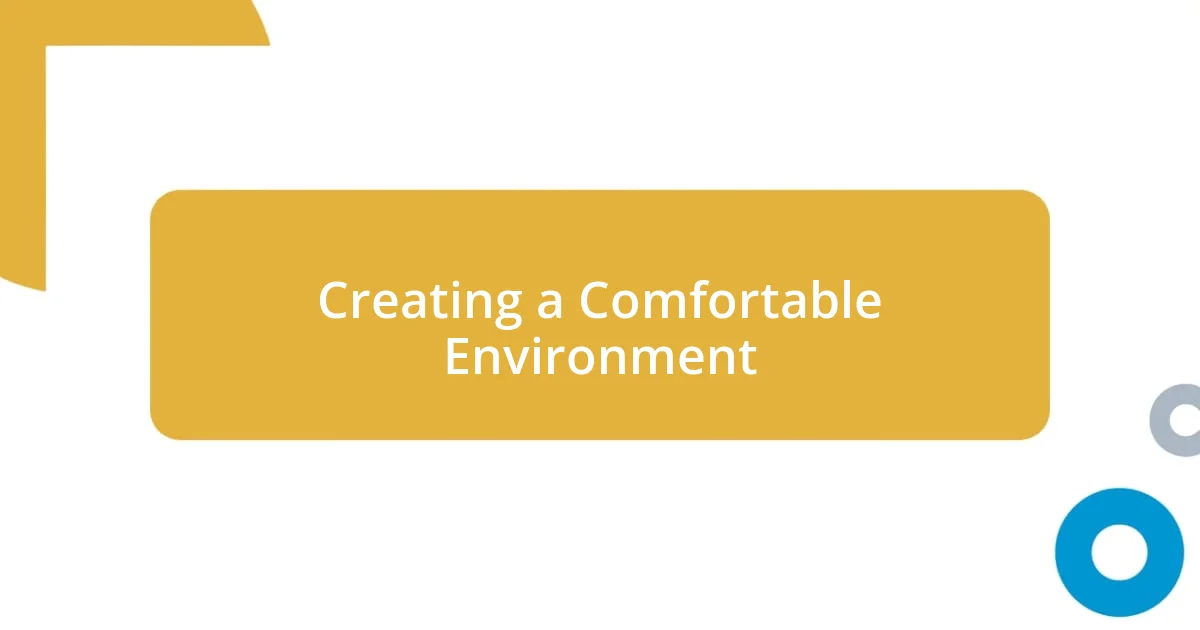
Creating a Comfortable Environment
Creating a comfortable environment for children is key to capturing their true personalities. I recall a photo session in a cozy home where we set up a playful scene with colorful cushions and toys. The child instantly relaxed because the space felt familiar and inviting. It’s amazing how the right surroundings can transform a child’s mood and openness before the camera.
To foster comfort during a shoot, consider these elements:
- Familiar Surroundings: Use locations like their home or favorite park.
- Interactive Props: Include toys or activities that capture their attention.
- Gentle Interaction: Engage with them through play to build rapport.
- Relaxed Atmosphere: Allow breaks and be patient; there’s no rush.
- Positive Reinforcement: Celebrate their efforts with compliments to boost their confidence.
By implementing these strategies, I’ve seen anxiety fade, giving way to genuine smiles and laughter. You can truly feel the difference when children feel at ease—it reflects beautifully in your portraits.
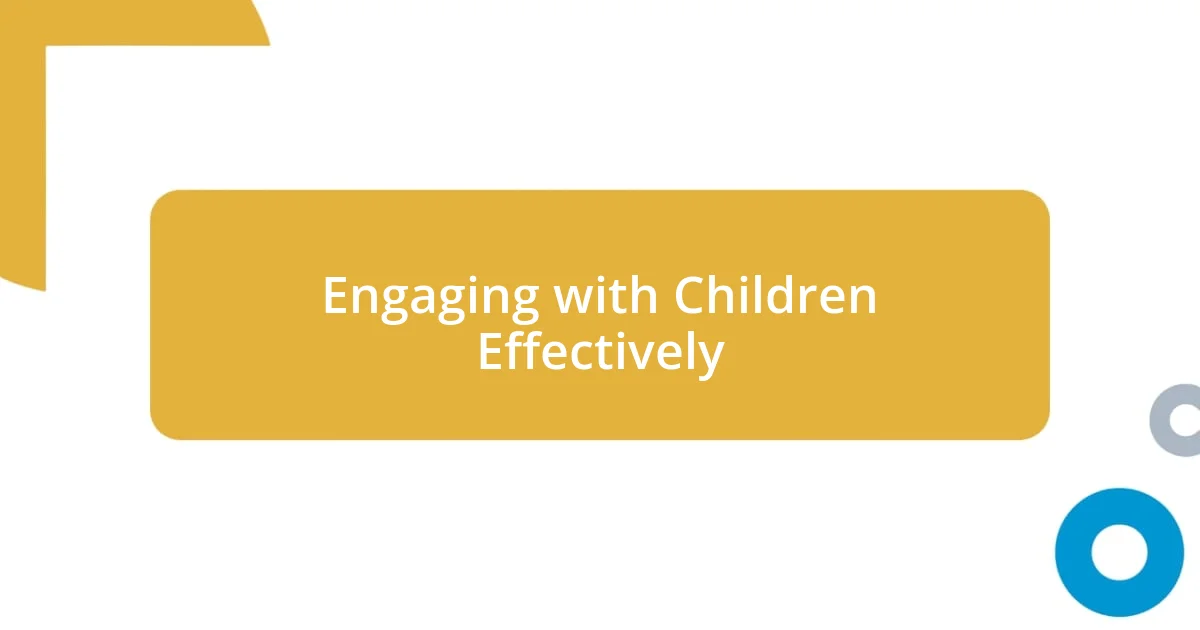
Engaging with Children Effectively
Engaging with children effectively is all about connection. I remember a session where I used a simple question about their favorite superhero to break the ice. That little conversation sparked a genuine smile and instantly changed the dynamic of our shoot. What I’ve found is that asking open-ended questions can draw out a child’s personality, allowing them to feel valued and heard.
For those moments when a child seems shy or reluctant, I turn to playfulness as my secret weapon. I once brought along a colorful bubble wand during a shoot. Watching their eyes light up with delight as bubbles floated around created a magical atmosphere and encouraged their natural curiosity. Isn’t it incredible how something as simple as bubbles can transform a session into a joyful experience?
Body language plays a significant role when interacting with young ones. I consciously lower myself to their eye level and make sure my expression is warm and approachable. Once, during a shoot, I continuously crouched down, mimicking the child’s playful antics. As a result, we shared laughter, and the images turned out to be not just portraits but cherished memories full of joy and spontaneity. How can you not smile when you’re fully engaged in their world?

Incorporating Playful Elements
To really capture the essence of a child’s spirit, it’s essential to weave in playful elements. I remember a time I brought along a colorful parachute to a shoot. The sheer joy on the child’s face as they ran under it, creating a stunning canopy of colors, was magical. At that moment, the camera became an extension of their laughter, encapsulating pure joy.
In my experience, incorporating games can also lead to some delightful portraits. For instance, I had a session where we played a quick round of “Simon Says.” When I instructed them to make silly faces, I was blown away by the authenticity of their reactions. Those genuine expressions are irreplaceable; they reflect a child’s unguarded nature, something that’s often hard to reach in more traditional settings.
Moreover, inviting a sibling or a favorite stuffed animal to join in on the fun can elevate the whole session. One time, having a beloved teddy bear alongside a little girl led to spontaneous giggles and shared secrets. Watching them interact reminded me how vital it is to create a narrative where children feel their personalities are center stage. After all, isn’t the magic of childhood all about play and imagination?

Mastering Posing Techniques
When it comes to posing techniques for capturing children’s portraits, creating an effortless environment is essential. I’ve found that allowing children to find their own poses often leads to the most authentic shots. Just the other day, I encouraged a little boy to choose a superhero pose that made him feel strong. The confidence radiating from him was palpable, and the resulting portrait was a perfect blend of power and playfulness. How rewarding is it to see their personalities shine through in that way?
Another technique I’ve used successfully is engaging siblings in the posing process. During one shoot, I let the kids show me how they usually play together and just followed their lead. They naturally fell into adorable poses, their interactions revealing the genuine love and connection they shared. There’s something truly precious about capturing those fleeting moments, don’t you think?
Incorporating elements of movement can also elevate the experience. During a recent session, I encouraged a group of children to skip toward me, arms outstretched, and the laughter that ensued was contagious. The genuine joy in their faces, coupled with their spontaneous movements, created portraits full of life and vibrancy. Isn’t it amazing how fleeting moments can capture the essence of childhood so beautifully?

Editing to Enhance Portraits
Editing plays a crucial role in bringing out the vibrancy in children’s portraits. I often start by adjusting the brightness and contrast, which can breathe life into a photo that might feel a bit flat. There was a portrait of a little girl jumping in a puddle, and with just a few tweaks, the colors of her bright yellow raincoat popped against the muted backdrop, perfectly capturing her spontaneous joy.
One technique I love is enhancing the skin tones to keep them natural while removing any distractions. I recall editing a photo where a child had smeared chocolate on their cheek—an adorable mess! By softening the skin a bit, I was able to keep that delightful imperfection while ensuring it didn’t detract from their infectious smile. Have you ever noticed that little quirks often make the best parts of a portrait? I surely have.
Adding a subtle vignette can also help draw the viewer’s attention to the subject. One time, during a lively birthday party shoot, I applied a gentle vignette to an image of the birthday boy surrounded by balloons. It created a dreamy focus that highlighted his joy among the chaos. It made me realize how these small touches can transform an already joyful moment into a cherished memory that truly resonates.












